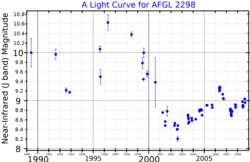 A near-infrared (J band) light curve for AFGL 2298, adapted from Clark et al. (2009) | |
| Observation data Epoch J2000 Equinox J2000 | |
|---|---|
| Constellation | Aquila |
| Right ascension | 19 00 10.89 |
| Declination | +03° 45′ 47.1″ |
| Characteristics | |
| Spectral type | B8I, B:I:, B0-0.5I |
| Apparent magnitude (J) | 12.164 |
| Apparent magnitude (H) | 8.918 |
| Apparent magnitude (K) | 6.91 |
| Variable type | LBV |
| Astrometry | |
| Distance | 30,000±10,000 ly (10,000±3,000 pc) |
| Absolute bolometric magnitude (Mbol) | −11.25 |
| Details | |
| Radius | 158 - 385 R☉ |
| Luminosity | 1,300,000 - 2,000,000 L☉ |
| Temperature | 11,000 - 15,500 or 26,000 K |
| Other designations | |
| V1672 Aql, RAFGL 2298, IRAS 18576+0341, 2MASS J19001089+0345471 | |
| Database references | |
| SIMBAD | data |
AFGL 2298, also known as IRAS 18576+0341, is a luminous blue variable star (LBV) located in the constellation Aquila, very close to the galactic plane. Its distance is not well known; it may be anywhere between 23,000 and 42,000 light years (7,000 to 13,000 parsecs) away from the Earth. Despite being extremely luminous, it is extremely reddened by interstellar extinction, so its apparent magnitude is brighter for longer-wavelength passbands; in fact, in visual wavelengths it is completely undetectable.
AFGL 2298 was discovered during the US Air Force Geophysical Laboratory (AFGL) survey, a rocket based infrared sky survey conducted at Hanscom Air Force Base, whose results were published in 1975.
AFGL 2298 has an absolute bolometric magnitude of −11.25, making it one of the most luminous stars known. Indeed, many of the hottest and most luminous stars known are luminous blue variables and other early-type stars. However, like all LBVs, AFGL 2298 is highly variable and the bolometric magnitude refers to its peak luminosity. Its status as an LBV was confirmed in 2003.
Like most extremely massive stars, AFGL 2298 is undergoing mass loss. For example, in 2005 it was estimated to be losing 3.7×10 solar masses each year, although the rate of mass loss itself varies frequently and dramatically. The stellar mass is currently being ejected as a nebula around the star (similar to AG Carinae), which was imaged by the Very Large Telescope in 2010. The nebula was found to be fairly circular, and the properties of the dust appeared to be constant throughout the entire nebula.
| Effective temperature (K) | Mass loss rate (M☉/yr) | Bolometric luminosity (L☉) | |
|---|---|---|---|
| June 2001 | 11,700 | 4.5×10 | 1.5×10 |
| August 2002 | 10,900 | 1.2×10 | 1.3×10 |
| June 2006 | 10,300 | 5.2×10 | 2.0×10 |
| May 2007 | 10,900 | 4×10 | 1.5×10 |
See also
References
- ^ Clark, J. S.; et al. (2009). "Bolometric luminosity variations in the luminous blue variable AFGL2298". Astronomy and Astrophysics. 507 (3): 1555–1565. arXiv:0909.4160. Bibcode:2009A&A...507.1555C. doi:10.1051/0004-6361/200912358. S2CID 119187994.
- ^ Cutri, Roc M.; Skrutskie, Michael F.; Van Dyk, Schuyler D.; Beichman, Charles A.; Carpenter, John M.; Chester, Thomas; Cambresy, Laurent; Evans, Tracey E.; Fowler, John W.; Gizis, John E.; Howard, Elizabeth V.; Huchra, John P.; Jarrett, Thomas H.; Kopan, Eugene L.; Kirkpatrick, J. Davy; Light, Robert M.; Marsh, Kenneth A.; McCallon, Howard L.; Schneider, Stephen E.; Stiening, Rae; Sykes, Matthew J.; Weinberg, Martin D.; Wheaton, William A.; Wheelock, Sherry L.; Zacarias, N. (2003). "VizieR Online Data Catalog: 2MASS All-Sky Catalog of Point Sources (Cutri+ 2003)". CDS/ADC Collection of Electronic Catalogues. 2246: II/246. Bibcode:2003yCat.2246....0C.
- Ramírez Alegría, S.; Herrero, A.; Rübke, K.; Marín-Franch, A.; García, M.; Borissova, J. (2018). "Identifying two groups of massive stars aligned in the l 38° Galactic direction". Astronomy and Astrophysics. 614: A116. arXiv:1801.08683. Bibcode:2018A&A...614A.116R. doi:10.1051/0004-6361/201731720. S2CID 119427413.
- ^ Clark, J. S.; et al. (2003). "Confirmation of the Luminous Blue Variable nature of AFGL 2298". Astronomy and Astrophysics. 403 (2): 653–658. Bibcode:2003A&A...403..653C. doi:10.1051/0004-6361:20030389.
- ^ Umana, G.; Buemi, C. S.; Trigilio, C.; Leto, P. (2005). "Current day mass loss rate for Luminous Blue Variable IRAS 18576+0341". Astronomy and Astrophysics. 437 (1): L1 – L5. Bibcode:2005A&A...437L...1U. doi:10.1051/0004-6361:200500126.
- Kazarovets, E. V. (2006). "The 78th Name-List of Variable Stars". Information Bulletin on Variable Stars. 5721: 1. Bibcode:2006IBVS.5721....1K.
- ^ "AFGL 2298". SIMBAD. Centre de données astronomiques de Strasbourg. Retrieved 26 January 2017.
- Walker, R. G.; Price, S. D. (July 14, 1975). AFCRL Infrared Sky Survey (PDF). United States Air Force. Retrieved 22 November 2024.
- ^ Buemi, C. S.; et al. (2010). "VISIR/VLT and VLA Joint Imaging Analysis of the Circumstellar Nebula Around IRAS 18576+0341". The Astrophysical Journal. 721 (2): 1404–1411. arXiv:1008.0997. Bibcode:2010ApJ...721.1404B. doi:10.1088/0004-637X/721/2/1404. S2CID 119281049.
| Constellation of Aquila | |||||||||||||
|---|---|---|---|---|---|---|---|---|---|---|---|---|---|
| Stars |
| ||||||||||||
| |||||||||||||
| |||||||||||||
| Nebulae |
| ||||||||||||
| Galaxies |
| ||||||||||||